The Optical Tube Of Omni XLT 150
Unlike older equatorially mounted 6” Newtonians, which were typically f/8 to f/10, the Celestron Omni XLT 150 reflector is a fast, short f/5. This focal ratio, I observed, yields a wider field and lower power with a given eyepiece, but it does require significantly more precise collimation. Also, it shows coma with a 2” wide-field eyepiece, though at f/5 I don’t strictly need a coma corrector to use the scope.
The optics in the Omni XLT 150 are of decent quality, though I don’t get the same kind of planetary performance a longer Newtonian reflector provides as its secondary mirror is larger in size relative to the primary mirror, decreasing contrast.
The Celestron Omni XLT 150 is collimatable as with any good Newtonian telescope, but Celestron doesn’t provide any collimation tools with the scope. A collimation cap, which is really all I need for most telescopes, can be easily made by putting a small hole in a 35mm film canister lid (which perfectly fits into the scope’s 1.25” adapter) and cutting off the canister’s bottom. Fine tuning can be done by centering and defocusing a bright star (preferably Polaris, as it doesn’t move) and adjusting the primary until the secondary mirror appears exactly centered.
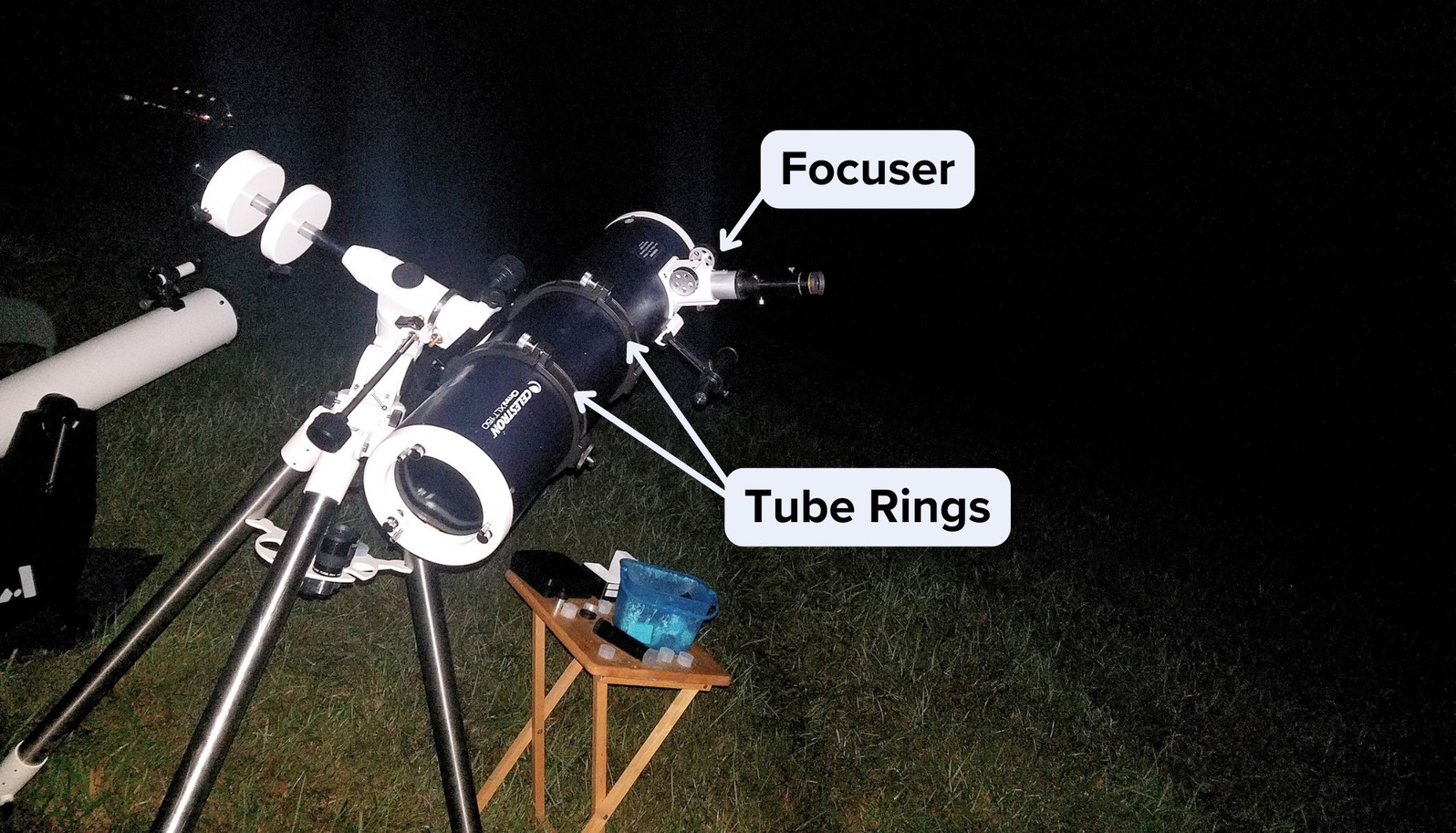
The Omni 150 comes with a high-quality 2” Crayford focuser and a 1.25” adapter. As seen in the above picture, this focuser is abnormally tall, as Celestron has taken pains to prevent the drawtube from intruding on the scope’s light path, a frequent problem I’ve noticed with small scopes. Being all-metal and including a tension adjuster, it is adequate for even the heaviest eyepieces or cameras.
The Celestron Omni XLT 150’s tube rings, which allow for rotating the eyepiece/finder position and balancing the scope, are metal and are bolted to a Vixen dovetail, which allows the scope to be put on almost any modern telescope mount. One of the tube rings has a ¼ 20 captive knob, which allows you to piggyback your DSLR camera on for wide-field shots if the scope is equipped with a motor drive.
Should Accessories be Replaced?
The Omni XLT 150 comes with a single eyepiece, a 25mm Plossl producing 30x. But I really benefitted from a good 2” wide-angle eyepiece (keep the focal length under 35mm, otherwise the exit pupil will be too large and you’ll lose light) and some 1.25” eyepieces, such as the popular and cheaply-available “goldline” 66-degree eyepieces.
The Omni’s finder is a cheap 6×30 unit. While it does work, it’s not very comfortable, and the images are quite dim. I recommend swapping it for a 50mm unit and/or getting a Rigel Quickfinder—a Telrad doesn’t have enough room in the scope’s optical tube.
Mount of Omni XLT 150
The Celestron Omni XLT 150’s mount is known as the Celestron CG-4, sometimes referred to as the Omni CG-4 so as not to be confused with the cheap, older black units on extruded aluminum tripods that Celestron used to bundle with some of their scopes in the late 1990s and early 2000s.
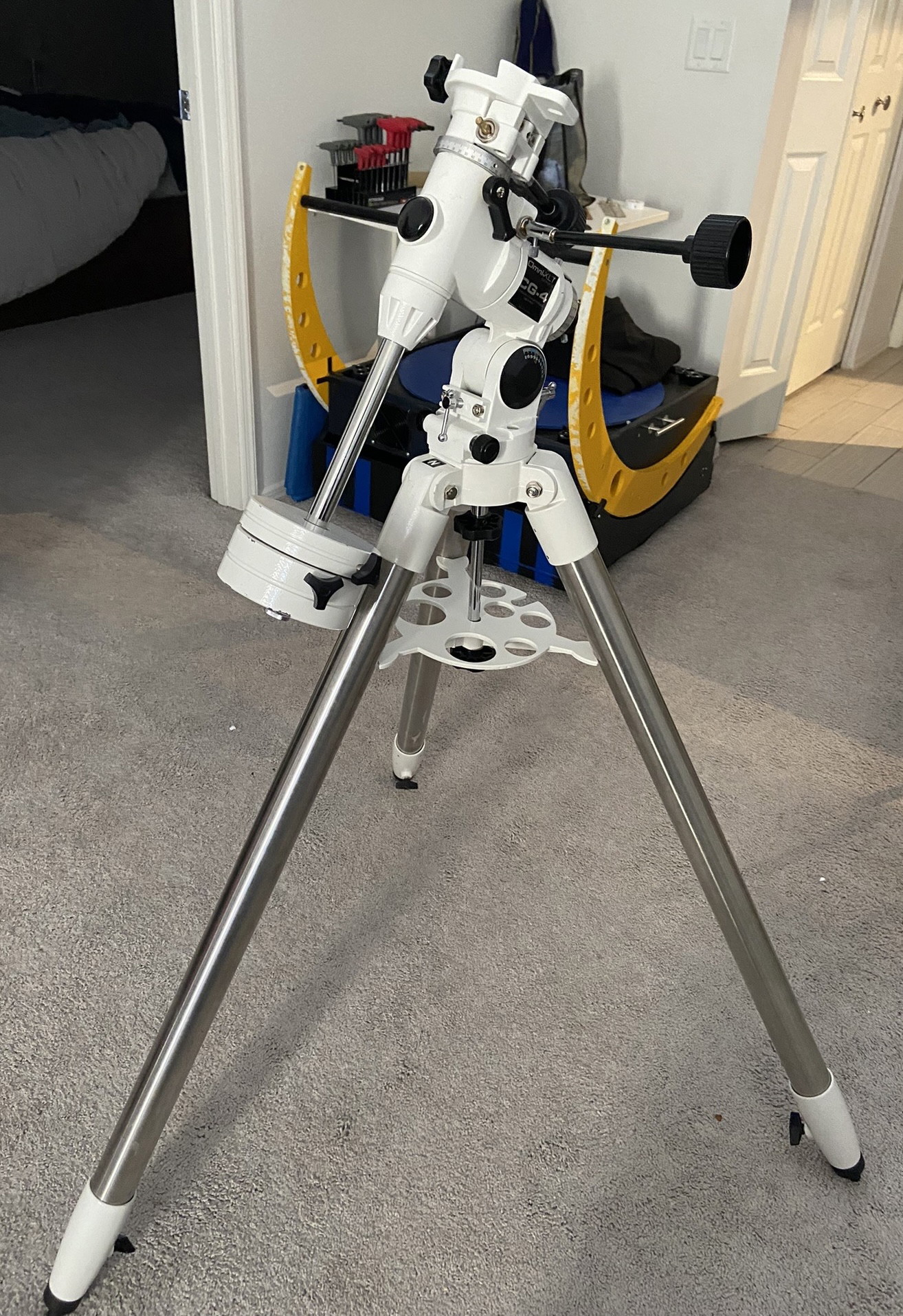
The CG-4 is basically the same mount head as an Advanced VX or older CG-5, completely stripped of all electronics, with a shorter counterweight shaft and on a slightly smaller tripod (1.75” steel legs as opposed to 2”).
Since the electronics and their housings are typically the most cheaply made parts of a modern, mass-manufactured equatorial mount, what I’m left with is an extremely high-quality mount that even twenty years ago would’ve been priced as much as the entire Omni XLT 150 package.
To give you an idea of how well-made the CG-4 is, I trust and use my $2,000 Takahashi FC-76 refractor on it. That is how good it is.
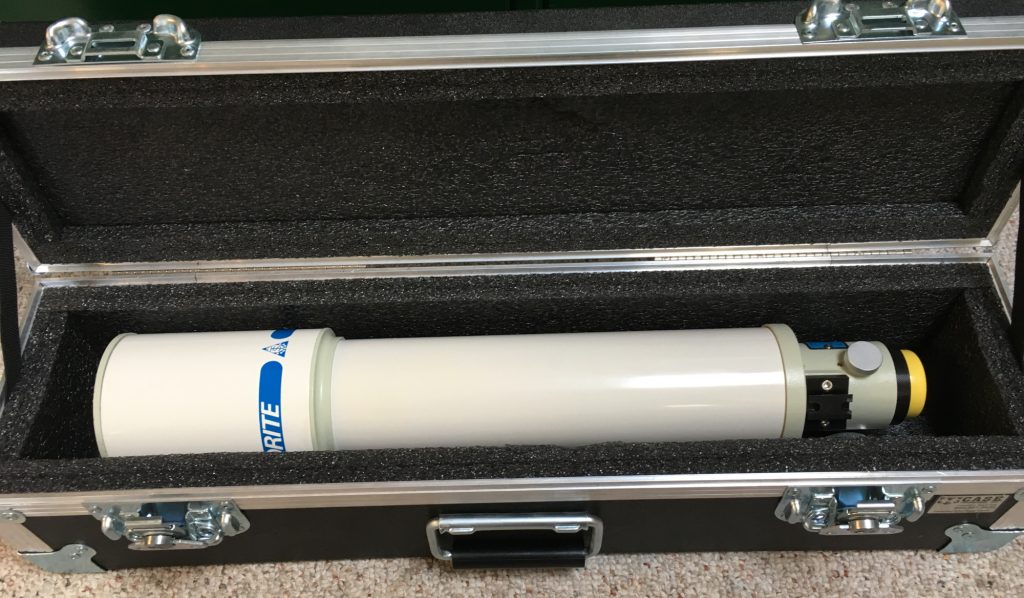
The CG-4 can be upgraded to have a dual-axis motor drive, which is essential for astrophotography. The dual-axis drive also allows you to slew the scope in either direction in right ascension or declination at the push of a button, which is convenient for centering targets without jiggling the scope.
The CG-4 can also be upgraded with a polar scope for precise polar alignment, another astrophotography requirement.
Unusually, the CG-4 comes with knobs for slow motion rather than flexible slow-motion cables. I don’t really have a preference, but you can get some cables for almost nothing if you prefer them over knobs.
Should I buy a Used Celestron Omni XLT 150?
If the price reduction compared to buying new is fair, then go for it. Be sure to check that the mount motions are smooth and that the mirrors aren’t corroded. Dust or dirt can be easily cleaned off. If the mount or counterweights are rusty or have chipped paint, they’ll still function as normal, but be prepared to offer less.
Alternative Recommendations
The Celestron Omni XLT 150’s high price, lack of included features or accessories, and the complexity and bulk of its equatorial mount make it far from our first choice in its price range, especially for beginners, despite the generally high quality of this telescope. Here are a few of the fine instruments we would probably recommend in its stead.
Under $700
- The Apertura AD8 features nearly double the light gathering ability and 30% more resolving power than the Omni XLT 150, with an easy-to-use Dobsonian mount, a dual-speed Crayford focuser with brass compression ring, a low-power wide-angle 2” 30mm SuperView eyepiece, laser collimator, 9×50 right-angle correct image finderscope, and built-in cooling fan included. The bearings have clutches, but the telescope stays where you put it and is easy to adjust just by pushing—there are no slow-motion cables, backlash problems, or polar alignment woes to be found with a Dobsonian like this one.
- The Explore Scientific 10” Hybrid Dobsonian offers about triple the light gathering power and 67% more resolution/sharpness than the Omni XLT 150 and collapses down into a portable and convenient package thanks to its easy-to-assemble truss tube, which requires no tools to put together or take apart. As with the Omni XLT 150, the included accessories are basic at best, but you’re getting a heck of a lot more telescope for the price, and on a super-simple and buttery smooth Dobsonian mount that is easy to aim around the sky and stays where you want it without any locks or clutches.
- The Sky-Watcher Virtuoso GTi 150P features the same exact optics as the Omni XLT 150 but substitutes the Omni XLT’s solid steel tube for a collapsible one, and the complicated and heavy equatorial mount is replaced with a fully motorized GoTo tabletop Dobsonian mount, controlled via your smartphone but also able to be pushed around the sky manually without affecting the alignment of the electronics. You get an extra included eyepiece, too. The Heritage 150P offered by Sky-Watcher is identical to the Virtuoso GTi 150P minus the electronics and is offered at a bargain-basement price tag (especially when compared to the Omni XLT 150, which retails for nearly double the price).
$700-$1000
- The Apertura AD10 has just about triple the light gathering area of the Omni XLT 150 or other 6” reflectors thanks to its huge 10” primary mirror. As with the AD8/Z8, you get a variety of well-made and thought-out accessories and features included, like a 2” dual-speed Crayford focuser, 9×50 right-angle finder, 30mm SuperView 2” wide-angle eyepiece, laser collimator, and even a built-in cooling fan—and mounted atop a simple, sturdy Dobsonian mount with adjustable bearings, with pretty much the same weight, length, and height as the AD8 or similar 8” Dobsonian models.
- The Celestron StarSense Explorer 8” Dobsonian is technically a manual Dobsonian telescope, but features Celestron’s StarSense Explorer technology to assist you in aiming it at “faint fuzzy” deep-sky objects that may be difficult to locate by charts alone, especially under light-polluted conditions. The StarSense Explorer 8” doesn’t come with much in the way of other features or accessories—just a single 25mm Plossl eyepiece, red dot finder, and single-speed 2” Crayford focuser are provided—but the base has cutouts and the tube features carry handles to increase portability, and the StarSense Explorer technology makes using the telescope a lot easier, especially for beginners.
- The Sky-Watcher 8” FlexTube Dobsonian features a collapsible tube to reduce the scope’s length slightly when stored or transported, which is helpful if you have very little storage space in your home and/or a very small vehicle. As with other 8” Dobsonians, this scope provides much brighter and sharper views than the Omni XLT 150 and is easy to set up and use. The included 2” single-speed Crayford focuser, 9×50 straight-through finder, and pair of “Super” Konig eyepieces are adequate, though the open tube of this telescope pretty much requires you to make or purchase a fabric shroud to achieve the best possible views. The collapsible tube also doesn’t result in any significant reduction in weight compared to a solid-tubed 8” Dobsonian, and the base is quite heavy too.
Aftermarket Accessory Recommendations
The main items we’d recommend adding to the Celestron Omni XLT 150 are a 6mm “goldline” eyepiece for higher magnification (125x) and a better finder of some sort. In addition to the 6mm, you may want goldlines or some other quality eyepiece in focal lengths of 9–10 and 14–16mm for more magnification options, such as the Explore Scientific 82-degree, or Baader Hyperion.
For a finder, we’d probably recommend a Rigel Quikfinder or an inexpensive red dot sight due to the Omni’s small tube. A 9×50 finderscope also works, but is a bit heavy and not very comfortable to look through. There isn’t enough real estate on the tube to really accommodate a Telrad.
What can you see with the Celestron Omni XLT 150?
The Celestron Omni XLT 150’s fast focal ratio and wide field of view make it especially suited as a “rich-field telescope” for sweeping the Milky Way and observing large star clusters. Under dark skies, you can also observe a lot of dark nebulae in the summer Milky Way with the Omni XLT 150. The German equatorial mount design makes wide-field sweeping with the Omni XLT 150 a little awkward, but you can get used to it after a little while.
So, what else is there to see with the Celestron Omni XLT 150 reflector telescope?
Inside the Solar System:
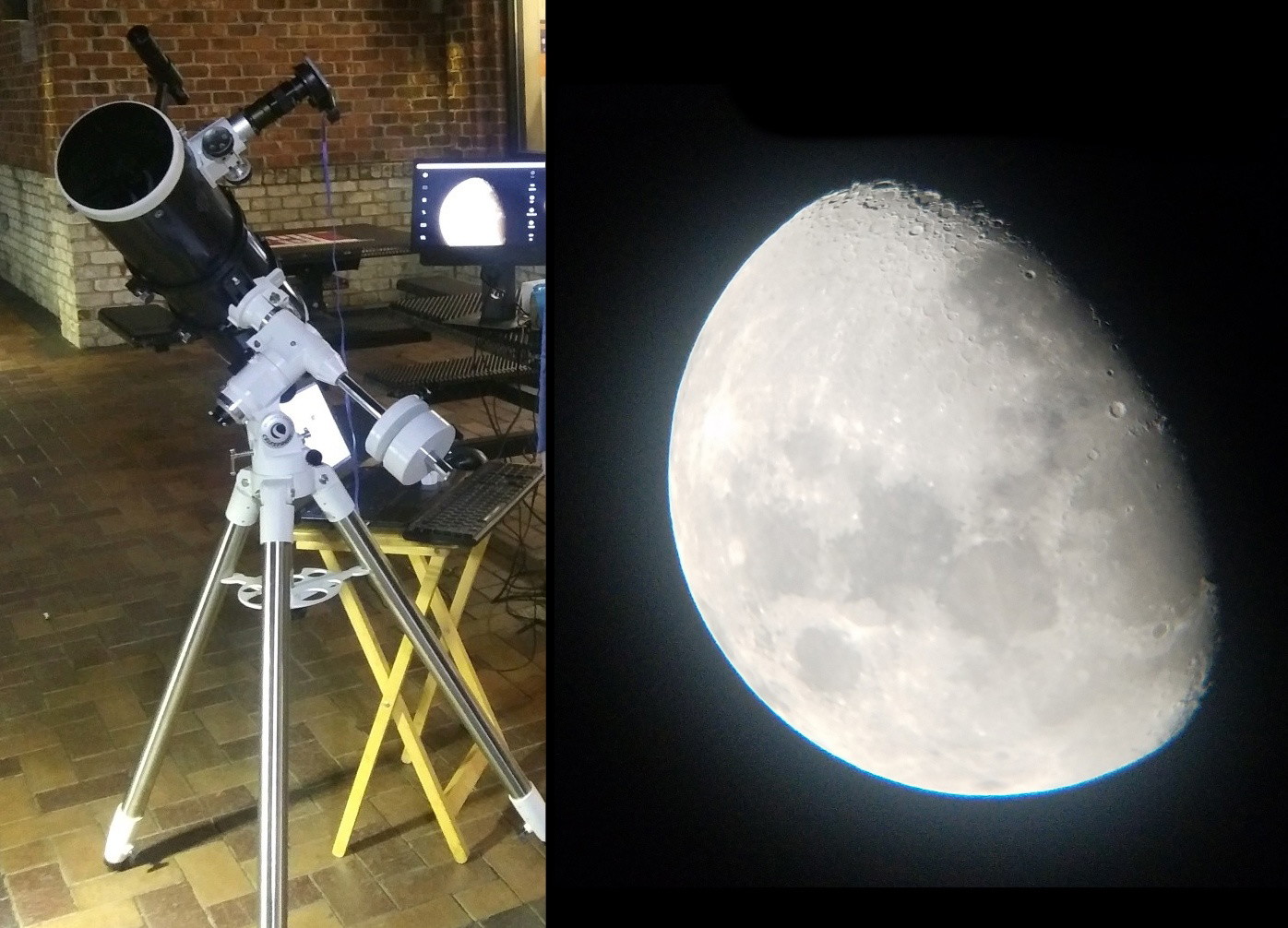
- The Moon: Craters down to about 2 miles in size, countless ridges, fault lines, valleys, mountains, etc.
- Mercury and Venus’ phases
- Mars’ ice cap and a few albedo features
- Jupiter’s bands, Great Red Spot, moons, and shadow transits
- Saturn’s cloud belts, rings, the Cassini division, and half a dozen moons
- Uranus as a teal/turquoise dot
- Neptune as an azure-gray dot, with its moon Triton faintly visible.
Outside the Solar System:
- ~50 globular clusters, ranging from the bright, partially-resolvable M13 to dim ones you’ll struggle to see at all.
- A couple dozen galaxies with discernable details and a few hundred to a few thousand visible total, depending on your skies.
- Hundreds of open clusters
- Dozens of planetary nebulae, some of which may show hints of color
- A dozen or two emission nebulae, such as Orion, the Lagoon, the Swan, and the Trifid
- Thousands and thousands of double stars.
- About 40 million stars in the sky are brighter than magnitude 14, the limit for a 6” telescope.
With 6” of aperture, good optics, and a wide low-power field of view, you will take a long time to run out of targets.
Astrophotography Capabilities
The Celestron Omni XLT 150 is capable of decent lunar and planetary imaging with a webcam-style CCD, but you will need a quality 5x Barlow (expensive and of no use visually) to boost the image scale sufficiently, and of course, a motor drive for hands-free tracking.
The Omni 150’s fast focal ratio and sturdy mounting do permit deep-sky imaging with a DSLR and the motor drive, but you do have limits. Without autoguiding, the scope is realistically limited to relatively short exposures, and you will have to throw out some frames. You can purchase a hand controller that allows for autoguiding, but an autoguider and a guide scope are expensive and add to the weight of the setup, straining the mount.
That being said, a 6” f/5 Newtonian on a CG-4 is probably the best thing I could recommend at this scope’s price point for deep-sky astrophotography—just remember to have realistic expectations.

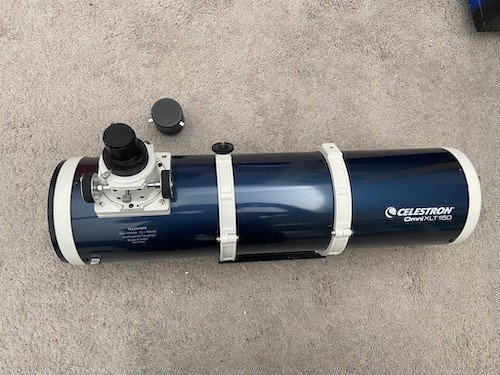


That’s actually a really good question. I would guess not, but with 6″ of aperture at f/5 it’s such a small difference that it’s near-irrelevant anyway.
Can you use the Omni XLT 150 with other computerized mounts?
Yes.
Yes. It comes with a dovetail bar, which is accepted by most mounts. I use mine on a Celestron AVX.
Hi,
is omni xlt 150 better when compare to omni xlt 120 and astromaster 130?
Yes but a Dobsonian is better than all three.
is there a recommendation for a 2” wide-angle eyepiece focal length under 35mm?
Meade 20mm UWA or Explore Scientific 24mm or 30mm 82
Thank you so much. I appreciate it.
Hello Zane,
Thanks for your detailed review. For a total newbie in search of his first telescope will you suggest this one over an Orion Starblast 6 ? What I’m not sure about the Starblast is its mount, since you need a table.
Thank you, ciao!
I’d get this or a full-sized 8″ Dob.
I purchased this scope as an OTA in late June 2020 as my entry into Electronically Assisted, and Astrophotography. I also own an 8″ Schmidt Cassegrain. They are both used on a Celestron AVX mount. Also used with this scope are a ZWO ASI 385 MC camera, and ASIair Pro control unit. It’s a great scope for this purpose without spending a fortune!
The only negative I’ve experienced was the quality control from the factory. Initial collimation could not have been worse, and the adjustment screws on the secondary mirror were so tight that I ruined the Allen key that was provided trying to loosen them. Had I been a beginner, I would have been lost and frustrated, as it was unuseable out of the box. Once I corrected it, I can’t say anything negative about it.
I forgot to add. It will accommodate a Telrad. I have one mounted, along with a 10 X 50mm 90 deg illuminated finderscope. The finderscope it comes with is a straight through 30 mm. If you love your back, you will change it out.
How does this Celestron OTA compare with the Apertura 6 inch f/5 Newtonian OTA, which is half the price on the High Point website?
Thanks.
Basically the same
Hi there!
I just got my Svbony goldline eyepieces kit to upgrade my telescope, but I’m looking for this model. Does the kit pieces work on this one?
Yes, it will accept any 1.25″ eyepieces such as the SVBONY ones
Hello, do you recommend this one over the Advanced VX 6″ Newtonian?
In a 1000 dollars budget what do you recommend for a equatorial mount telescope? (Not a fan of Dob)
Thanks you very much